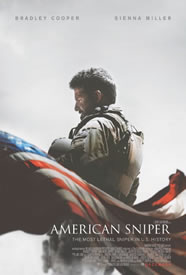Also posted on Chronicle of Higher Education: http://chronicle.com/blogs/conversation/author/rpells/
 Ava DuVernay’s Selma and Clint Eastwood’s American Sniper have both been lavished with praise and award nominations. They are also the focus of intense historical and political controversy. Normally, I don’t believe movies should be judged by their historical accuracy. They are dramas, and occasionally, works of art. But any consideration of these two films can’t be divorced from the events they describe. And as historical interpretation and as drama, I think, Selma is terrible while American Sniper is terrific.
Ava DuVernay’s Selma and Clint Eastwood’s American Sniper have both been lavished with praise and award nominations. They are also the focus of intense historical and political controversy. Normally, I don’t believe movies should be judged by their historical accuracy. They are dramas, and occasionally, works of art. But any consideration of these two films can’t be divorced from the events they describe. And as historical interpretation and as drama, I think, Selma is terrible while American Sniper is terrific.
Each movie deals with violence and death. There the similarity ends. DuVernay was a publicist before she became a documentary filmmaker. It’s not surprising, therefore, that Selma combines a documentarian’s effort to record the historical truth with the aura of a public-relations spectacle.
On the other hand, Eastwood has long been a master director. And he has been preoccupied with the ambiguities and gruesomeness of violence through much of his later career: in movies like Unforgiven (1992), Mystic River (2003), and Letters From Iwo Jima (2006). Moreover, Eastwood is a consummate storyteller; his tales of haunted characters are revealed to the audience with economy, precision, and eloquence. There are few wasted moments in an Eastwood movie, and little overt social commentary. His focus is almost always on individuals trapped in a snare of their own making.
Academic historians too often judge movies by how faithful the films are to the historical record. But that perspective overlooks the need for films to create characters and to tell a story that will have an emotional impact.
In that sense, DuVernay has the tougher job. She has set out to portray as fully as possible the grand tale of the 1965 civil-rights march from Selma, AL, to the state capital in Montgomery. The purpose of the march was to generate support in the North for a bill to establish and defend the voting rights of African-Americans in the South. DuVernay, therefore, faced the double task of capturing the struggles of the march’s leaders—especially Martin Luther King Jr.—while remaining as historically truthful as possible.
Too often, she fails at both tasks. On the historical and political level, Selma has been reproached for its one-dimensional, if not false, depiction of Lyndon Johnson. In the movie, he is depicted as opposing the march, while according to Oval Office tapes and (admittedly biased) accounts of his White House advisers, he conceived of the march much as King did: as a way of intensifying America’s revulsion at the violent methods of Southern segregationists and increasing popular approval for a voting-rights law.
There are plenty of reasons for criticizing Johnson, not least for plunging the country deeper into the Vietnam War. But shepherding two major civil-rights bills through Congress in 1964 and 1965—the most comprehensive legislation protecting the rights of black people since Reconstruction—are not among those reasons.
In response to the criticism, DuVernay has said she needed moments of dramatic tension. She’s right. But her inaccuracies about Johnson aside, her movie is devoid of any drama.
DuVernay’s characters don’t argue or laugh with one another; even when they disagree with their fellow civil-rights leaders, they don’t seem to enjoy one another’s companionship. Instead—and this is especially true of the representation of King—they give speeches to each other. They don’t talk; they declaim. And they are extraordinarily dour.
Of course, as befits a historical film, everyone shows up, at least momentarily. Coretta Scott King, Ralph Abernathy, Hosea Williams, John Lewis, Andrew Young, James Bevel, Bayard Rustin—they’re all here. Even a chastened Malcolm X puts in an appearance, apologizing to Mrs. King for his opposition to her husband’s nonviolent tactics. Yet if you don’t know anything about the complexities of the movement, or the intrigues and tensions among King’s acolytes, you would have no idea who these people are—a curious weakness in a historical drama.
In another historical saga, Lincoln, Steven Spielberg and Daniel Day-Lewis humanized their hero, making Lincoln a shrewd political operator as well as a man with an often-vulgar sense of humor. In Selma, the actors—particularly David Oyelowo as King—give wooden performances because the script offers them nothing to do except be monuments to and participants in a noble event. Ironically, only Tim Roth gives his role any intricacy; he plays George Wallace with a malevolent glee.
I can’t help wondering what Spike Lee—who was originally interested in making a movie about the Selma march—might have done with the subject. Or better yet, Quentin Tarantino. Maybe Tarantino would have cast John Travolta as Lyndon Johnson, Samuel L. Jackson as Martin Luther King, and Christoph Waltz as J. Edgar Hoover. At least Tarantino’s film would have been more fun, if even more historically (and politically) incorrect.
DuVernay’s Selma is well-intentioned. But good intentions do not make a good movie.
The majority of the debate over American Sniper has been political. A smash commercial hit, it’s been lauded by the commentators on the right as a tribute to American patriotism and for appealing to the conservative heartland. It’s been denounced by those on the left as a simple-minded rationalization for the war in Iraq. The movie is neither. It’s not political at all.
Instead, American Sniper exposes the viciousness and horrors of the Iraq War from the viewpoint of the individual American soldiers who have to kill the enemy and, at the same time, avoid being slaughtered or maimed. As in a Hemingway novel, the words “sacrifice” or “heroism” have little meaning. Doing one’s job well is the sole criteria for survival.
American Sniper, however, is both historical and biographical. The movie is based on the life (and death) of Chris Kyle, played formidably by Bradley Cooper. Kyle, who served four tours of duty in Iraq, was the ultimate “volunteer.” Trained by the Navy SEALs as a sniper, he was credited with 160 “kills” but was often embarrassed when his fellow soldiers called him a “legend.” Warned by his austere father that there were three types of people in the world—sheep, wolves, and sheepdogs—Kyle became a sheepdog, whose task was to protect American soldiers from being massacred by the enemy, even if that enemy was a child or a woman.
The trauma of the war remained with Kyle when he returned home. Indeed, Eastwood has said he was making a movie not only about war but also about family. Like most veterans of any war, Kyle had difficulty readjusting to civilian and married life. As Cooper portrays him, Kyle is usually inarticulate and spooked by sounds resembling explosions. It is only when he begins to help other veterans, many of them badly wounded and psychologically damaged by the war, that he finds a new purpose as a sheepdog. And, although the movie doesn’t mention this, he started to train as a policeman. It is therefore both ironic and tragic that he is killed by a disturbed veteran on a firing range, a melancholy conclusion that the film announces in white letters on a barren black screen.
There is no way to watch this movie without being unsettled. While Selma never allows us to get emotionally close to the characters or the historical events, Eastwood and Cooper make it impossible for audiences—whatever their political allegiances—to be indifferent to what they’re watching.
Indeed, the film Sniper most resembles is The Deer Hunter, released in 1978 and exploring the emotional effects of another catastrophic war, this one in Vietnam. The Deer Hunter was equally controversial, decried by its ideological opponents as an apology for America’s venture in Vietnam. Yet The Deer Hunter was as preoccupied with the emotional consequences for those who fought in Vietnam as is American Sniper with the scarred veterans of Iraq.
Among the more devastating moments in both films are the scenes of homecoming. Robert De Niro, like Bradley Cooper, personifies a veteran ravaged by his recollections of the war, initially unable to relate to any of his friends, taking refuge in silence. And, of course, there is in both movies the mantra of “one shot,” the sniper’s credo as well as the goal of the deer hunt (early on, we see Kyle as a boy killing a deer with a single bullet), and the horrific scenes in The Deer Hunter of Russian roulette.
I do not understand how anyone can see The Deer Hunter or American Sniper and think that either movie glorifies the wars in Vietnam or Iraq. I once showed The Deer Hunter to a group of seminar students, and the film left them in tears. I think American Sniper would have the identical effect.
The issue, then, is what makes a movie historically and cinematically authentic. And what moves an audience. Selma, for all its ambition, leaves us untouched by its effort to replicate the past. Nor does the film impel us to care about its personalities.
American Sniper does not permit us to turn away from the torments of the war or from the agonies of its characters. It is precisely its passion for truth-telling and its concentration on its complicated characters that make it both a sophisticated work of history and a dazzling film.

